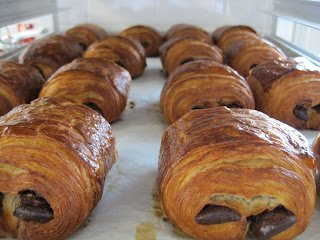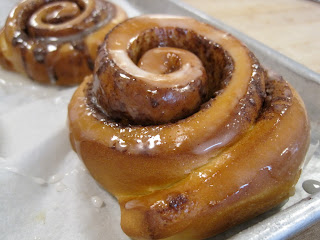Then Sunday morning came... a little more tired than usual, I woke up for class. Imagine my surprise (and panic) when my clock said 6:32, which is already two minutes later than I need to leave my house, not to mention the fact that I still had bright pink fingernails (a major no-no in the culinary department). So after a stop at CVS for fingernail polish remover, since of course I couldn't find any at my house, I arrived to room 301 twenty minutes late. Apparently, I wasn't the only one who hadn't shown up, and our chef had already combined groups. This left me joining a group to make a group of 5, which is really not desirable, since we would be getting in each other's way all day. After apologizing for my tardiness, (which was appreciated and accepted), chef looked around and decided that it might be best for me to work with him for the day, doing side work and prep. He asked if I would be alright with this, to which I casually (as casually as I could anyway) said, "Sure!"
Getting to work with the chef all day was busy, busy, busy, but awesome! I got to prepare different kinds of dough for demos, make Russian braid, hazelnut, apple, and cream cheese fillings, and pastry cream. I did start to feel a teensy bit self-conscious when other people in my class started calling me "sous-chef"; it was sort of reminiscent of being called "teacher's pet" in elementary school. It was nice to have answers to questions and be able to help people out, but I don't at all like it when I feel that people think I think I'm somehow better than them. (Know what I mean??)
Anyway, after being on my feet all day, learning tons of things about pastry, the huge box of goodies I brought home from class included the following delicious items:
Russian Braid
Tea Rings (2 of them)
Banana Bread muffins
Sour Cream Coffee Cake muffins
Croissants
Danishes
and last but not least, Brioche with hazelnut filling, chocolate sticks and crumb topping
Anyone in the mood for some pastries? :)
Chef said I did a great job on my tea rings (he might have even said they looked better than the ones he made that day for the demo!)
Check out how you make them here:
After preparing the dough, you layer it with cinnamon filling and cake crumbs (which help absorb moisture). That 1-2 inches of open dough on the left is important.. you'll see why!
Then you roll up the dough, not too tightly, not too loosely. (Here is the chef making a demo ring).
Then, tuck the end of the cylinder into the dough that didn't have the filling, making a ring.
You then cut the dough at an angle with scissors, fanning out the cut pieces just a bit.
After baking, the tea ring gets a glaze of apricot nepage and cinnamon roll glaze. (I put some sliced almonds on one ring too!)
Besides all the exciting baking in class yesterday, I also did a lot of other baking. For my friend's dress rehearsal dinner, I made vanilla-coconut cupcakes with 3 different kinds of buttercream: coconut, lime, and chocolate (so so so delicious!). Here are some pictures of those:
The "trial" cupcakes to test the frosting :)
(coconut buttercream in the front)
Chocolate buttercream: pre-toasted coconut
Lime buttercream (with the swirl and sugar sprinkles)
Big cupcakes (regular size) with coconut mixed into the batter, chocolate buttercream and toasted coconut.
Also, I made gingerbread men with my kiddos in school on Friday. They loved it! (And the hallways smelled like Christmas!) I decorated some and then they each decorate their own as well.. nothing like bringing home two cookies instead of one!






































